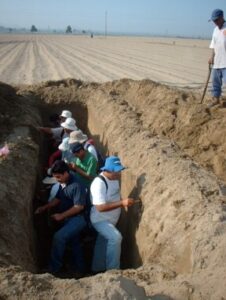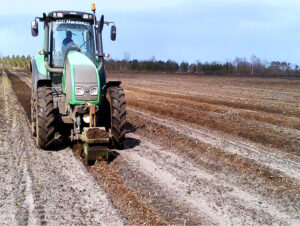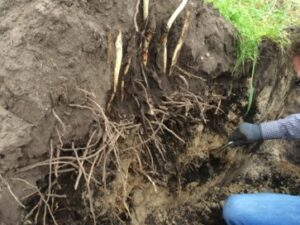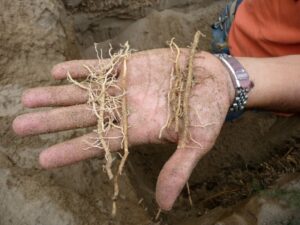Deep tillage has profound benefits for asparagus
The initial establishment of an asparagus plantation deserves special attention because its later technical and economic success depends upon it. And this is particularly the case when asparagus is being replanted in a field where it has previously been grown. The development of rotary spaders (Farmax and Imants), however, has provided a way to facilitate the establishment of an asparagus crop. Preparing the soil to a depth of up to 1.1 m allows the creation of a homogeneous zone which favours the plant’s growth. The addition of soil conditioners and fertilisers makes it possible to harness the “soilless cultivation – in the soil” approach developed by Christian Befve&Co. This involves taking the following steps before planting the crop.

1. A soil study starting with a physical and chemical analysis of the soil structure at two levels: the surface layer (to a depth of 30 cm) and the subsoil (from a depth of 50 cm). (See image 1.) A visual soil evaluation via the “profil cultural” method is necessary. The purpose of this profile is to determine if there are indications of life in the soil, such as the roots of previous crops. Their depth gives indications of possible areas of compaction, ground water level, differences in soil structures (sand, clay, gravel, etc.) -photo 2- The depth at which the deepest roots are located will determine the depth of the subsequent tillage.

2. A significant addition of organic matter – from 80-150 tons/hectare depending on the nature of the soil improver – improves the structure and fertility of the soil. Organic matter from local sources is recommended. Depending on what is available nearby, manure (from cows, horses, sheep or poultry), grape pomace or vegetable waste (rice husks, crushed palms) may be used. The application must be concentrated on the planting row as the rotary spader passes over it in order to provide the best possible conditions for the plant to grow. (See images 3 and 4.) The addition of microorganisms (e.g. Bacillus and Trichoderma) improves soil health and limits growth of pathogenic fungi (e.g. Fusarium sp., Rhizoctonia).

3. Tillage creates a favourable area for root development by creating a larger volume of soil than would otherwise be available. This can be achieved with hand tools, as in Madagascar (image 5), or via use of tillage machinery (images 6 and 7). In either case, the roots are able to extend abundantly throughout the area that has been tilled.

4. Observation of the roots in both areas, under tillage as well as the no-till soil, clearly shows the benefits of deep tillage (namely use of a rotary spader). In the tilled soil, the roots are numerous, white with large fibrous rootlets (left). In the no-till area, the roots are brown, soil fungus is present and there are only a few rootlets (right).
5. Tillage provides long-term benefits for an asparagus farm. In this comparative table based on the average yield of 14 asparagus plantations in 5 different countries, it can be seen that soil prepared with a rotary spader delivers higher yields than no-till soil from the very first harvest and the maximum potential continues to increase each year for the first six years. In contrast, without use of a rotary spader, the yield is lower and potential peaks in the 5th year. Over the years, the production potential is always greater with the spader and there is greater longevity (+2 years). In total, over the lifespan of the asparagus farm, this soil preparation technique delivers a 50% higher yield than no-till.
6. The increase in the volume of loose, healthy and fertile soil is the key to this greater yield thanks to its promotion of root development. Observations 4 months after planting indicate that the root systems in a soil tilled by a rotary spader have 30% more roots per plant, with a depth of establishment twice as great, and a vertical orientation. This establishment slows the usual rise of the root system level to 0.5 cm per year instead of 3 cm, and thus keeps it to just 5 cm after 10 years instead of 30 cm. As a result, the crop is productive for longer.






















